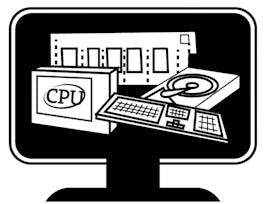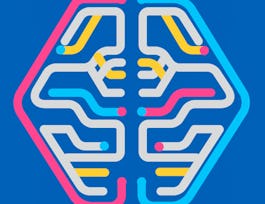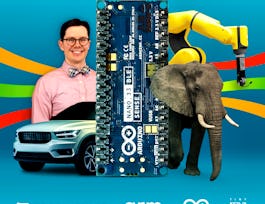The age of machine learning has arrived! Arm technology is powering a new generation of connected devices with sophisticated sensors that can collect a vast range of environmental, spatial and audio/visual data. Typically this data is processed in the cloud using advanced machine learning tools that are enabling new applications reshaping the way we work, travel, live and play.



Getting Started with Machine Learning at the Edge on Arm
Instructor: Arm Education
Sponsored by Taipei Medical University [C4CB]
Recommended experience
Skills you'll gain
- Computer Science
- Machine Learning Methods
- Embedded Systems
- Embedded Software
- Artificial Intelligence
- Artificial Intelligence and Machine Learning (AI/ML)
- Applied Machine Learning
- Tensorflow
- Artificial Neural Networks
- Machine Learning
- Deep Learning
- Supervised Learning
- Statistical Machine Learning
- System Software
- Machine Learning Algorithms
- Computer Vision
- Machine Learning Software
- Software Systems
Details to know

Add to your LinkedIn profile
31 assignments
See how employees at top companies are mastering in-demand skills


Earn a career certificate
Add this credential to your LinkedIn profile, resume, or CV
Share it on social media and in your performance review

There are 6 modules in this course
In this module, you will be introduced to key concepts in Machine Learning and learn why businesses now need this technology to be available on low-power devices.
What's included
3 videos2 readings3 assignments
In this module, you will explore some of the key concepts in machine learning, such as feature extraction and classification models, in the context of signal processing. You will understand the importance of training and evaluation in the machine learning workflow, and the constraints involved when using microcontrollers for this. At the end of the module, you will complete a practical lab exercise, to implement some simple machine learning models for activity recognition, using accelerometer data. To do so, you will be shown how to use Anaconda and Python to work with datasets.
What's included
7 videos1 reading7 assignments
This module dives deeper into a powerful and widely used model in Machine Learning: the artificial neural network. These can analyze large quantities of input data in complex ways, in order to solve classification problems, such as identifying objects in an image. In order to run neural networks on small microprocessors, these models need to be as streamlined as possible. So you will also look at the complexity of a typical neural network, and see some techniques to reduce this complexity, such as quantization. In the lab, you will continue building a classifier for activity recognition, but this time using a neural network on an Arm STM32 microprocessor. For this, you will be introduced to the TensorFlow Python library, which is also popular for many applications in machine learning.
What's included
6 videos1 reading5 assignments
Neural networks can be used to solve complex classification problems, as you have already seen. In this module, you’ll discover a more advanced model: the convolutional neural network. These are important for image processing, as they can interpret relationships between adjacent pixels, but they are also used in other applications such as financial modeling. This is a new and modern technique so you’ll be learning about the cutting edge of machine learning, and the recent trends in this field. In the lab, you’ll develop a convolutional neural network for audio processing, and optimize it for both accuracy and performance. This would allow it to give good results on a small device without draining the battery or delaying the response.
What's included
5 videos1 reading5 assignments
The algorithms used in modern machine learning can be very complex, and require many iterations of innovation and testing by computer scientists. This is especially true for the optimized algorithms required by microprocessors! Thankfully, you do not need to implement these algorithms yourself, as they are available in libraries, such as CMSIS-NN, developed by Arm. This module shows you how this library can be used for machine learning—for example for image processing using convolutional neural networks. In the lab exercise, you also have the opportunity to use CMSIS-NN to develop a simple model for the CIFAR-10 dataset, using CUBE AI.
What's included
5 videos1 reading5 assignments
For machine learning to perform well, even on the smallest devices, it is essential to optimize the models to minimize their memory footprint and the number of operations required to perform inference tasks. In practice, this allows portable devices to be more responsive, and extends their battery life. In this last module, you’ll explore some of the cutting-edge techniques used to optimize neural networks, such as using fixed-point arithmetic in place of floating-point arithmetic. To consolidate your learning, you will develop the best machine learning model that you can, that would be able to run on an ArmCortex-M microprocessor, using a toolkit such as CMSIS-NN.
What's included
6 videos1 reading6 assignments1 plugin
Instructor
Offered by
Why people choose Coursera for their career




Recommended if you're interested in Computer Science

University of London

Google Cloud

Edge Impulse

Open new doors with Coursera Plus
Unlimited access to 10,000+ world-class courses, hands-on projects, and job-ready certificate programs - all included in your subscription
Advance your career with an online degree
Earn a degree from world-class universities - 100% online
Join over 3,400 global companies that choose Coursera for Business
Upskill your employees to excel in the digital economy


